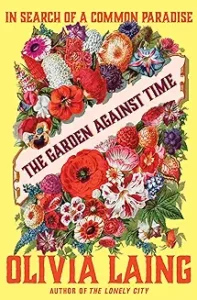The Garden Against Time: In Search of a Common Paradise by Olivia Lange 2024
I loved this book. It checked all the boxes for me. Laing writes with clarity, erudition, and passion as she weaves together gardening, social history, and bios and explorations of some of my favorite writers and social critics, especially W.G. Sebald, as well as some obscure figures I had never heard of. Even Sir Thomas Browne, the Zelig of literary criticism, makes an appearance.
Laing, the recipient of a Windham-Campbell Prize for non-fiction in 2018, bought an old house in Suffolk with her husband, Ian Patterson, a poet and translator and began the process of resurrecting its gardens which had fallen into a disastrous decline. While she’s rooting out dead cherry trees and carting off dozens of barrows of weeds, she delves into the history of the English garden and how it has always reflected the social hierarchy and the dominant system of power and money. Paragraphs about sweet peas and particular kinds of yarrow and perennial geraniums are punctuated by long and fascinating explorations of Milton’s “Paradise Lost”, Sebald’s “Rings of Saturn”, Diana Athill’s (a favorite British writer) memoir “Alive, Alive, Oh!”, the poetry and natural history writing of the 19th C John Clare, the fascinating design artist William Morris’s move towards socialism, and finally extensive descriptions of Mark Rummery who designed the garden that Laing inherited and Derek Jarman who built a unique garden on Scotland’s coast as he was dying of AIDS.
If that sounds like a bit of a jumble, it is, but it’s a fascinating, engaging, and beautifully written jumble. For Laing, the act of sinking her hands into the soil or compost, is in addition to being a creative and natural act, also a social action, reflecting how land is distributed and used. Ruminations about nearby great homes and estates lead to a detailed history of the Middleton family who made their money off of slave labor in sugar plantations in Antigua before moving to Charleston, SC to continue their slave enterprise and then on to Suffolk where they used their wealth to build bedding gardens. The Enclosure Acts of the early 19th C are another example of how power and government moved millions of acres of public land on which small farmers worked to huge private estates, and the negative aftermath of those changes.
The famous and the little known, her garden and the impact of the enclosures, the idealists and the capitalists, fecund life and inevitable decline and death in nature—Laing draws these contrasts together in this wonderful exploration of our relationship to the land and the attempt to train nature and its abundance for our needs, among them the contemplation of beauty.
In his NYT review, A.O. Scott wrote: “She belongs in an as-yet-undefined and perhaps undefinable class of prose artists who blend feeling and analysis, speculation and research, wit and instruction as they track down the elusive patterns and inescapable contradictions of modern experience. If I were in an algorithmic mood, I’d mention Geoff Dyer, Teju Cole, Jenny Diski (who was married to Ian Patterson until her death in 2016) and W.G. Sebald. Since Dyer and Sebald are two of my favorite writers, it’s clear that Scott, like me, loved this book and you may as well.



